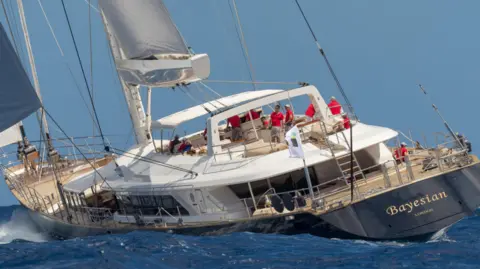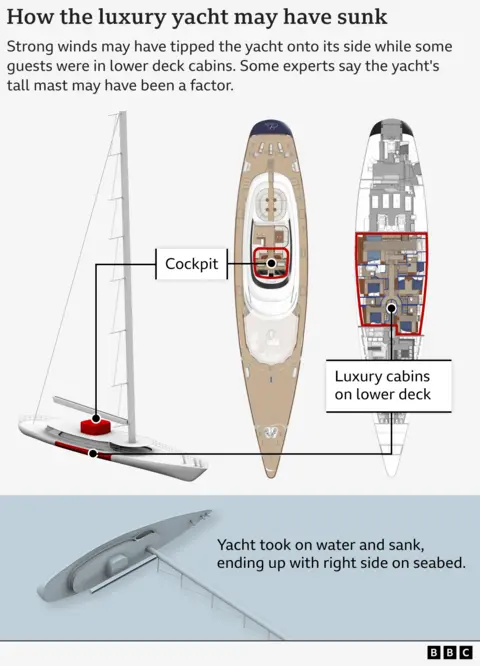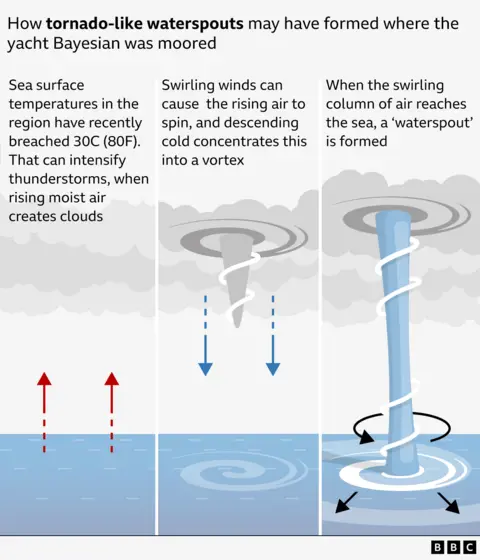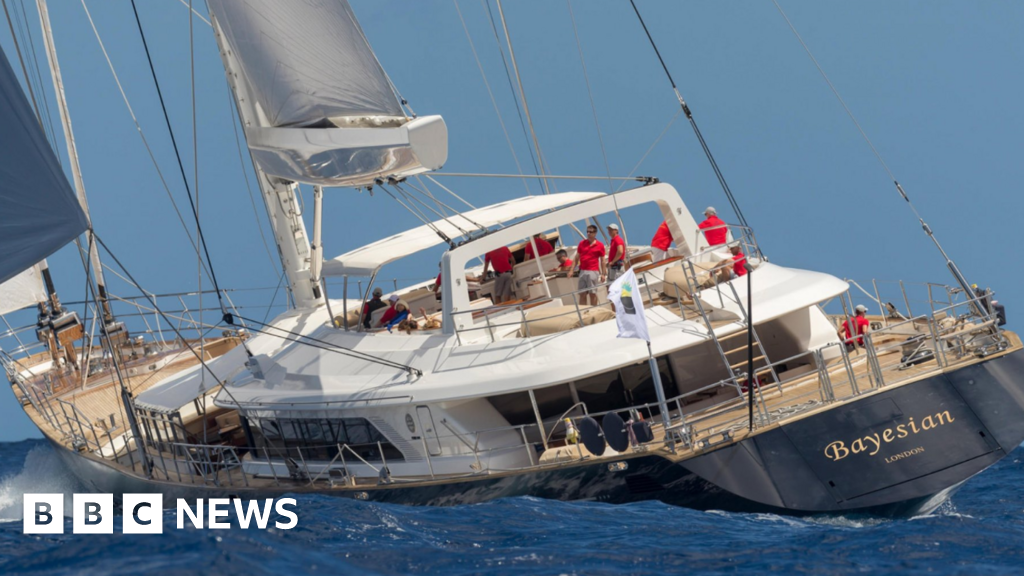 Perini Navi Press Office
Perini Navi Press OfficeSpecialist divers continue to search for six people who were onboard a luxury superyacht which capsized off the coast of Sicily on Monday morning – but questions have been asked about why the vessel sank.
According to vessel tracking app Vesselfinder, the boat left the Sicilian port of Milazzo on 14 August and was last tracked east of Palermo on Sunday evening, with a navigation status of “at anchor”.
It is believed the ship was struck by a tornado over the water – otherwise known as a waterspout – causing Bayesian to capsize.
There are separate reports the boat’s mast snapped during the freak storm and other factors in the boat’s sinking include water entering through hatches and doors which had been left open because of warm weather off the Italian coast.

Waterspouts – more common in Italy than you think
Witnesses have described seeing a waterspout form during the storm before the sinking of the Bayesian.
Most are familiar with what tornadoes look like – they are rotating columns of destructive winds, protruding from the base of clouds down to the ground.
According to BBC Weather, waterspouts are just that too, but are over water rather than land.
Instead of dust and debris swirling around the core of strong winds, it is water mist whipped up from the surface.
Like tornadoes, most are only short-lived, narrow columns and are not easily picked out on weather radars, so many will go unreported.

However, they are not as rare as you may think.
According to the International Centre for Waterspout Research there were 18 confirmed waterspouts off the coast of Italy on 19 August alone.
In the northern hemisphere, waterspouts are most common in late summer and through the autumn, when sea temperatures are at their highest, fuelling the storm clouds.
However, with sea temperatures rising due to climate change there is a concern that they could become more common.
In the last week, the Mediterranean has registered its highest sea surface temperature on record, which has helped to energise this recent storm outbreak.
Did Bayesian’s mast snap?
The Bayesian was built by Italian shipbuilder Perini in 2008 and was last refitted in 2020.
According to Perini’s website Bayesian has a 75m (246ft) mast which it claims is the tallest aluminium mast in the world.
Karsten Borner, the captain of another yacht anchored nearby at the time of the storm, said there was a “very strong hurricane gust” and he had to battle to keep his vessel steady.
He saw the Bayesian’s mast “bend and then snap”, according to Italy’s Corriere della Sera daily newspaper.
But, providing an update on the rescue mission, Marco Tilotta, from the Palermo fire service divers’ unit, told AFP the ship was lying on its side in one piece.

Matthew Schanck, chair of the Maritime Search and Rescue Council, explained it is difficult to say whether the mast broke.
“I think, and this is pure guess work, but the evidence that we are getting from the divers is the vessel is basically intact, lying on its side reportedly,” he told the BBC.
“If the mast was broken, that would be a significant thing that would be reported.”
Mr Schanck added he believed what happened to Bayesian was “a freak event”.
“Vessels aren’t designed to be out sailing in that weather – 65 to 85mph that’s the top of what a vessel would be out in and that’s with its sails down,” he said.
“They aren’t designed to sail through tornadoes or water spouts.”
Record-breaking Mediterranean temperatures
Since mid-June the sea surrounding Sicily – the western Mediterranean Basin – has been experiencing a severe heatwave.
The European Union’s climate change service, Copernicus, has been reporting sea surface temperatures in the region have repeatedly breached 30°C (86F) – four degrees higher than the 20-year average for this time of the year.
Spanish researchers at the Institut de Ciencies del Mar in Barcelona confirmed last Thursday the maximum sea surface temperature record had been broken in the Mediterranean Sea.
In both 2023 and 2024, the record was broken for the highest average temperature recorded around the world on one day.
Scientists put the rapidly rising temperatures down to climate change – oceans have taken the brunt of rising temperatures absorbing around 90% of the excess heat.
Following last year’s record ocean temperatures, Prof Mike Meredith from the British Antarctic Survey told the BBC: “The fact that all this heat is going into the ocean, and in fact, it’s warming in some respects even more rapidly than we thought it would, is a cause for great concern.”
Human elements – keeping doors and windows open
One sailing expert says hatches and doors left open overnight on the Bayesian may have caused it to sink.
Weather records show temperatures reached about 33C the day before the sinking
Sam Jefferson, editor of magazine Sailing Today, believe this may have led to the Bayesian’s occupants wanting air to flow through while they slept.
“I would have said that the boat got hit very hard by the wind, it was pinned over on its side,” Mr Jefferson said.
 EPA
EPA“I imagine all the doors were open because it was hot, so there were enough hatches and doors open that it filled with water very quickly and sank like that.
“The reason it got pinned over so hard was because the mast is huge. It acted almost like a sail. [It] pushed the boat hard over on its side.
“[The boat] filled with water before it could right. This is all speculation, but that’s the only logical explanation.”


